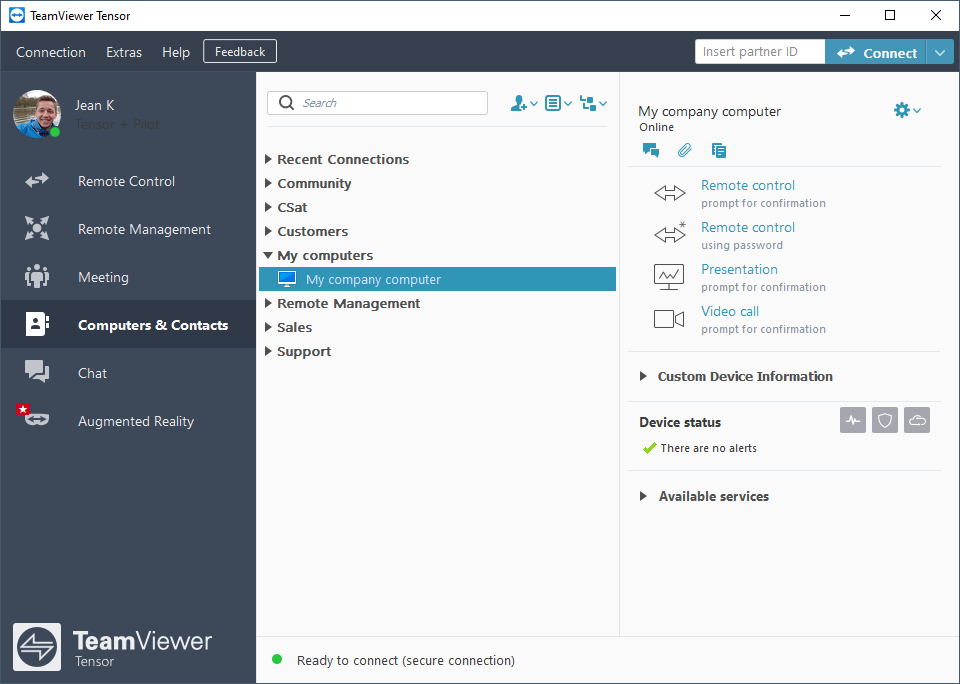This article applies to all TeamViewer Tensor customers.
TeamViewer Tensor provides a secure, easy-to-use remote work infrastructure, so your teams can access company resources like desktop computers, mobile devices, server systems, and applications, or intranet sites from home or on the go.
Get Started
Step 1
Download and install TeamViewer on your device: teamviewer.com/download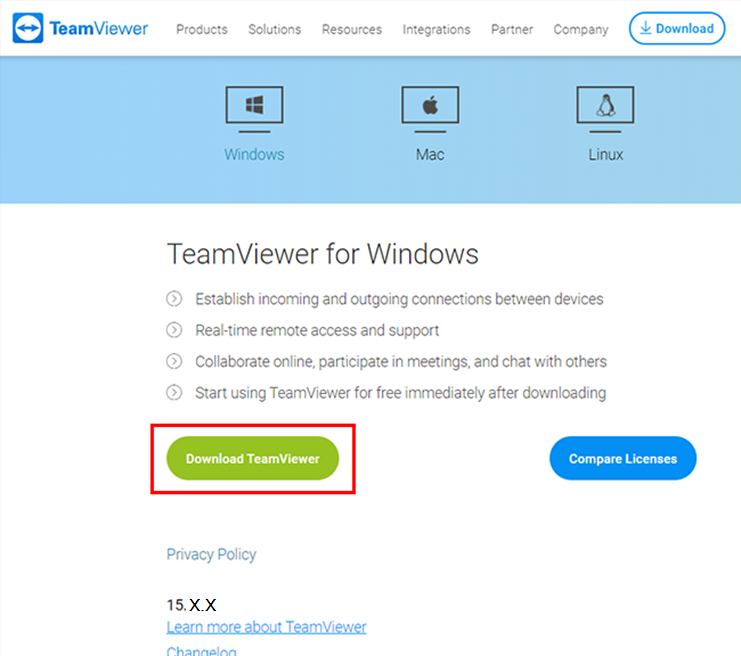
Step 2
Open the License Activation email that was sent to the email account used to purchase the license. Click "Activate".
Note: If you have purchased more than one product, each license must be individually activated.
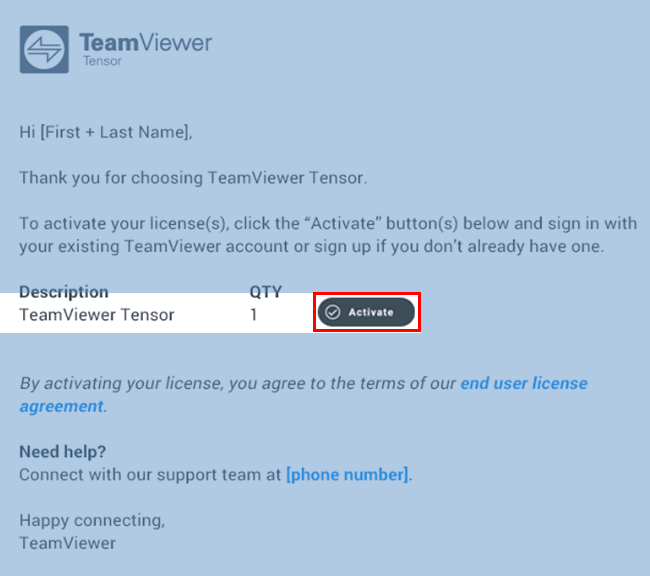
Step 3 - Follow A or B
A: If you already have a TeamViewer account
Sign in with your existing TeamViewer account, click Activate and go to Step 4.
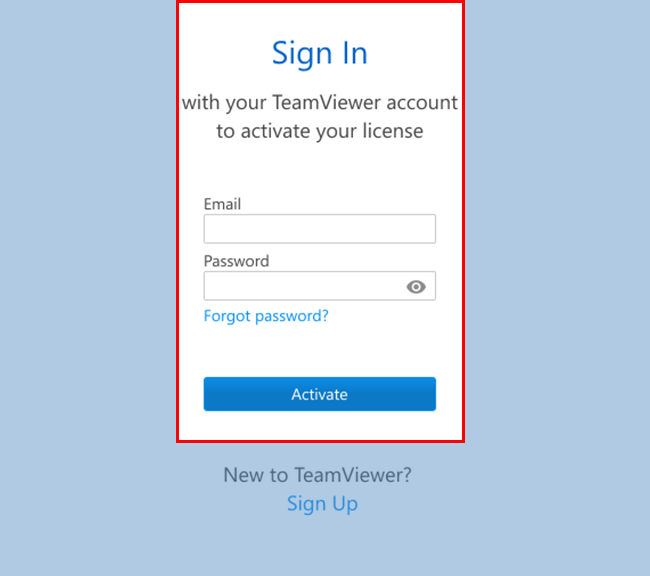
B: If you do not have a TeamViewer account
- Create an account by clicking Sign Up.

-
Enter your email address, name and create a password. Read and accept the EULA and mark the captcha box. Click Activate.
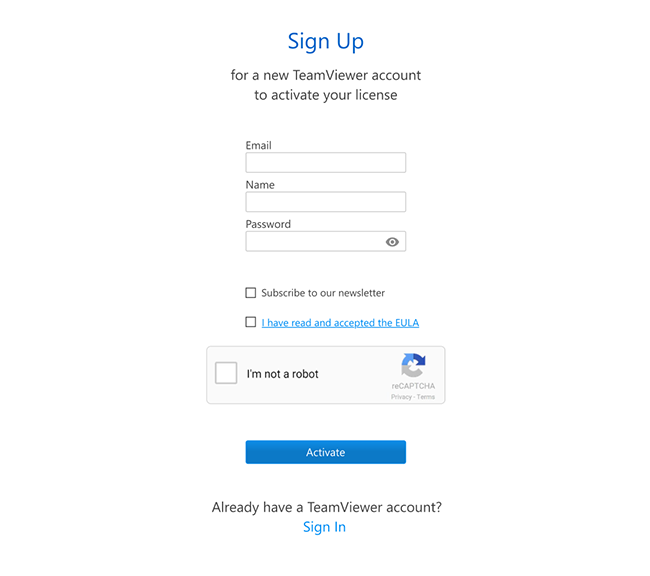
-
An email has been sent to your inbox for account verification. Click the link in the email to verify your account and complete your license activation.
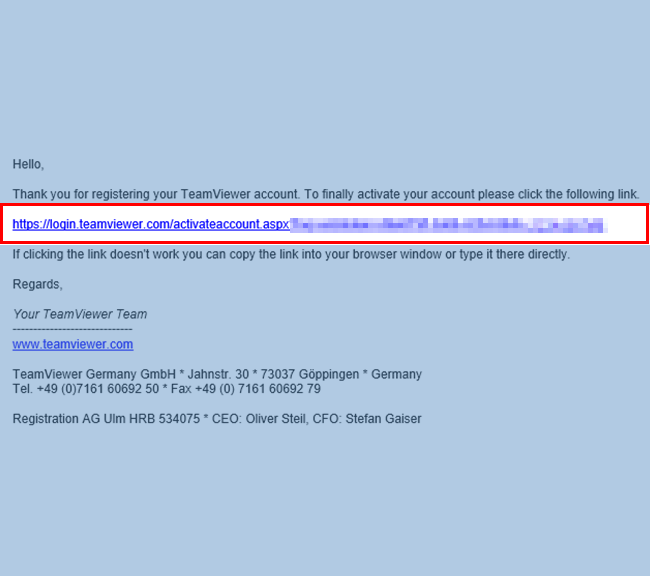
Step 4
You will be redirected to the Management Console where a pop-up that confirms your license was successfully activated. Click "OK".
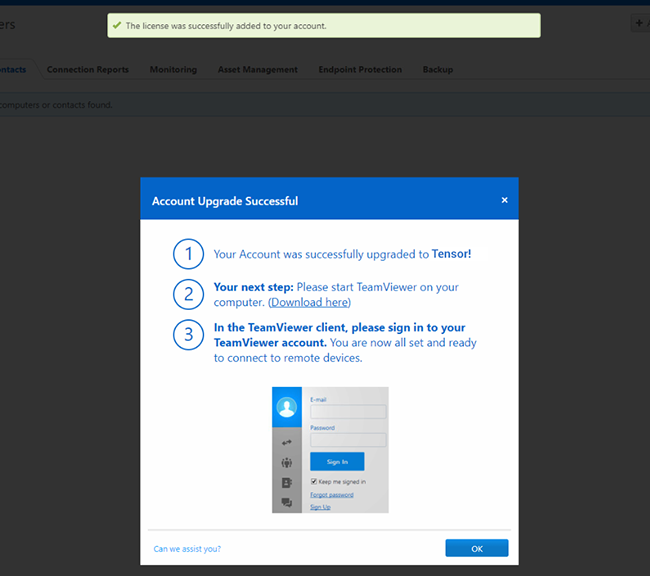
Step 5
A pop-up is displayed with the option to open the TeamViewer application. Click Open TeamViewer.
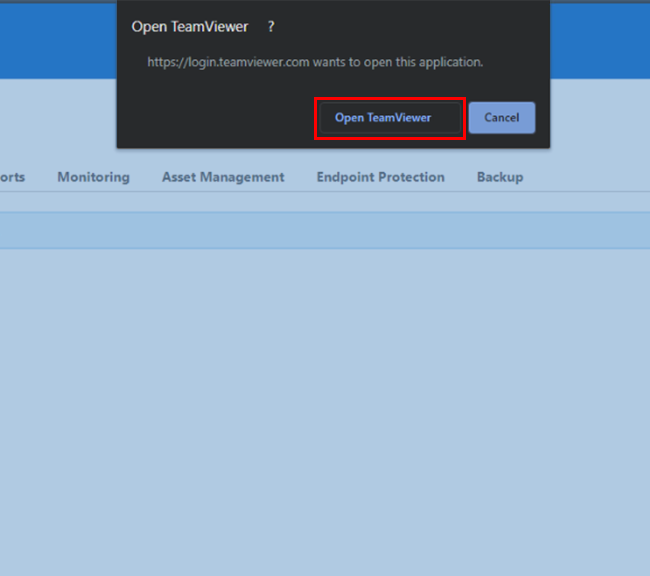
You are now signed into your TeamViewer account and have successfully activated your license.
Note: Please keep in mind that you always need to be signed in to your TeamViewer Account to have licensed connections. If you are not connected, you will be running with the free version.
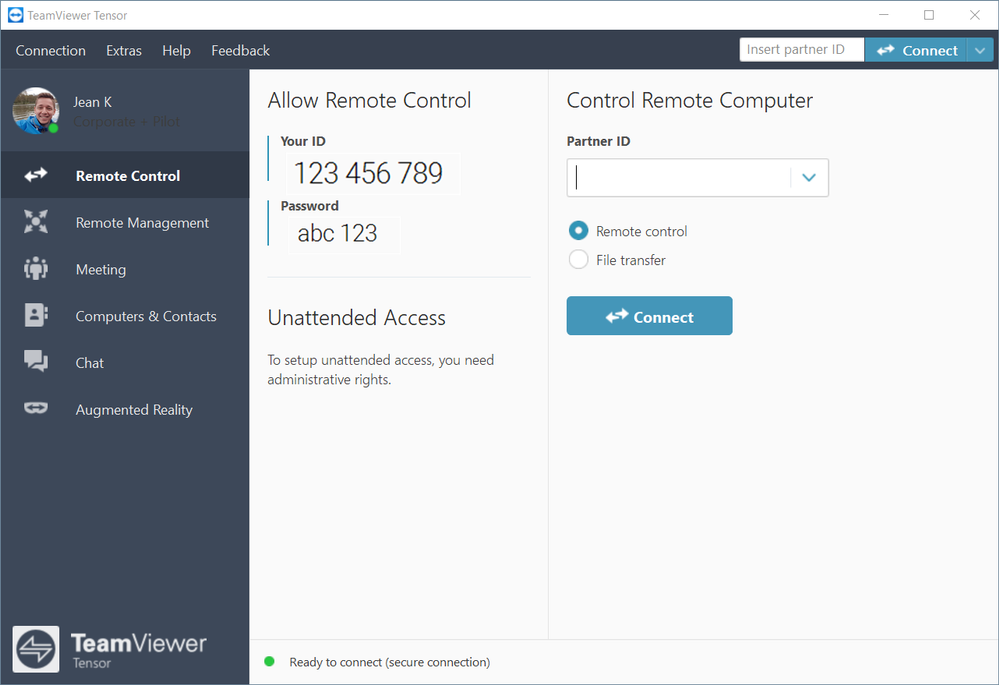
Step 6 (Optional)
Follow the instructions for two-factor authentication in our Knowledge Base article Two factor authentication - Activation and Deactivation to complete the activation of your TeamViewer license. If you want to skip this step, click Not Now.
Create your company profile and a Master Account in the Management Console
2.1 Create a company profile by following the instructions in the section Create your company profile.
2.2 Once your company profile is created, we highly recommend creating a Master Account, which will serve as a generic administrative account.
Why create a Master Account?
- Your company’s primary administrator(s) of TeamViewer will know the account credentials.
- This account will be used for all future configuration steps, so administrative control and ownership are not tied to one specific person.
- TeamViewer administration won’t be disrupted, even if the original administrator leaves that role.
For more details, follow the steps in our Knowledge Base article Using a Master Account for the TeamViewer Management Console
Please note:
- Make sure you do not create a Master Account with an e-mail distribution list (e.g., all@example.com), but with a specific e-mail address.
- The created account must have a valid email address that can receive the account activation email (i.e., either a mailbox or an email distribution list you have access to).
- We recommend using a non-personal email address for the Master Account.
- We highly recommend protecting your TeamViewer account with two-factor authentification. For details, please refer to our Knowledge Base article Two factor authentication - Activation and Deactivation
Create users
Under User management in the left navigation panel of the Management Console, click Add user to add people to your company profile that need to access their company devices remotely, along with every person that needs to be set up for remote work.
Follow the detailed steps in our Knowledge Base article All about the TeamViewer company profile

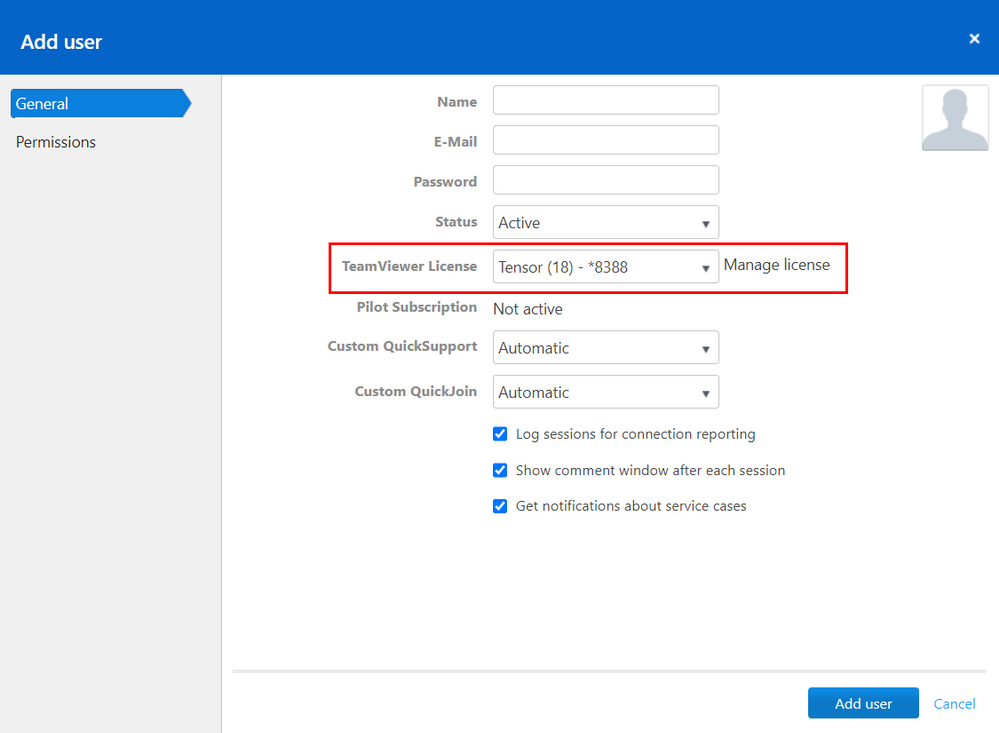
Please note:
- All users will receive a confirmation email for account activation.
- Users will have to log in in order to activate their account and set a password. TeamViewer Tensor allows the use of single sign-on (SSO). Please visit Single Sign-On (SSO) for more information.
With TeamViewer, you may want to use the following options down the road:
Create a group for your new devices
In the Management Console, click All in the left navigation panel.
Click Add group to create a group for your new devices. Later, the group for each company device will need to be shared with your remote workers.
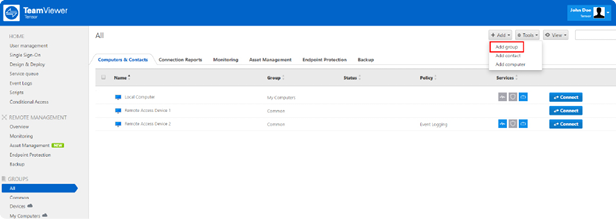
Add new settings policy
The settings policy facilitates the management of your installed TeamViewer clients. You can centrally enforce settings and options for them.
In the Management Console, click Design & Deploy in the left navigation panel and then click Add policy.
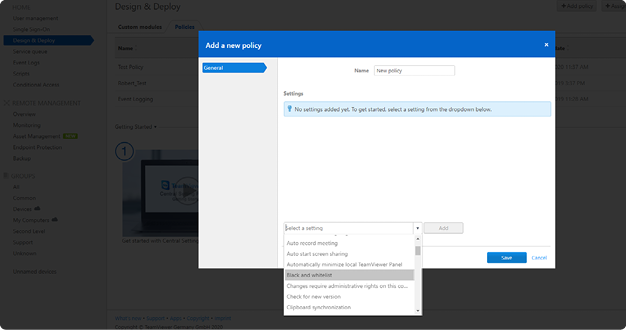
Follow the detailed steps in our Knowledge Base article How to add a new settings policy .
Recommended policies for this scenario:
- Blacklisting and whitelisting: Add your entire organization and click the option Allow access only for the following partners and then Add. In the following dialog, select the option with your company name.

- With this option, all members of your Your Company will be whitelisted
Note: All connection attempts from others will be blocked, even if they know the TeamViewer ID and the password of the target computer.
- Access control (incoming connections): Select Full access.
We recommend to use the following custom settings: 
- Start TeamViewer with Windows: Select Enabled.
- Disable TeamViewer shutdown: If activated, TeamViewer cannot be shut down. This is useful, for example, if the administrator wants to guarantee the continuous availability of a computer.
- Prevent removing account assignment: Account assignment of the remote machine cannot be changed. The only way to remove the account assignment is to disable the policy.
- Password strength: Select Disabled (no random password). Easy access will be granted to your remote workers instead.
- Report connections to this device: If activated, connections to this device will be reported and can be viewed in the TeamViewer Management Console. For more information, see the manual for Management Console, section 7.2 “Device reports”, page 56.
- Changes require administrative rights on this computer: TeamViewer options can only be changed by Windows user accounts with administrative rights.
Please note:
- We recommend enforcing all policies.
- Enforced policies can only be changed in the Management Console.
Deployment on Company Devices
Step 1: Create a deployment package for your TeamViewer Hosts
1.1 In the Management Console, click Design & Deploy in the left navigation panel and then click Custom module. Select the option Host in the drop-down menu.
1.2 Check or uncheck Allow customer to initiate a service case depending on if you want to allow customers to create service cases. Visit Improve support in teams with the Service Queue for more information about this feature.
1.3 Use the editing options on the left side to customize your Host. On the right side:
- A: Enter a name.
- B: Select the group you created in Step 4.
- C: Select the policy you created in Step 5.
- D: Activate Allow account assignment.
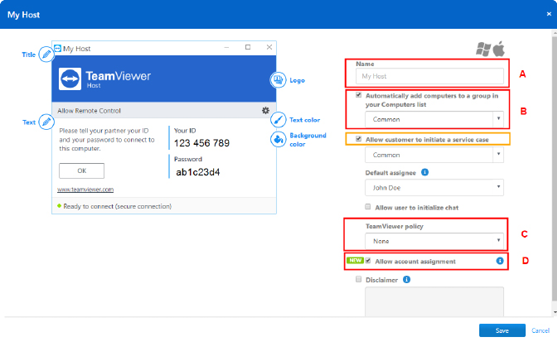
Note: By assigning a device to your Master Account, the device can be remotely managed and monitored by the Master Account at any time. The assignment is mandatory if you want to apply policies.
1.4 Click Save.
Step 2: Deploy your Hosts
IMPORTANT: Before you start any deployment, make sure to check your company firewall configuration:
1. Firewall configurations for ports:
- TCP/UDP PORT 5938:
- For performance reasons, we recommend opening the TCP/UDP port 5938 (outgoing). On networks that allow UDP protocols, TeamViewer attempts to get a peer-to-peer connection (will be tried with udp.teamviewer.com). TeamViewer prefers making outbound TCP and UDP connections over port 5938 — this is the primary port used for the best performance possible.
- TCP PORT 443:
- If TeamViewer can’t connect over port 5938, it will next try to connect over TCP port 443. Note: Port 443 is also used by our custom modules which are created in the Management Console. If you’re deploying a custom module (e.g., through group policy), then you need to ensure that port 443 is open on the computers to which you are deploying. Port 443 is also used for a few other things, including TeamViewer update checks.
- TCP PORT 80:
- If TeamViewer cannot connect over port 5938 or 443, it will try using TCP port 80. The connection speed over this port is slower and less reliable than ports 5938 or 443 due to the additional overhead used. There is no automatic reconnection if the connection is temporarily lost. Therefore, port 80 is only used as a last resort.
2. Firewall configuration for URLs:
Allow these TeamViewer processes for antivirus purposes:
- TeamViewer.exe
- TeamViewer_Desktop.exe
- TeamViewer_Service.exe
Allow the following URLs on the proxy/firewall level:
The deployment of your Hosts on your remote workers' computers depends on the deployment method you use. We recommend referring to the Knowledge Base article Mass deployment improvements for more information.
Step 3: Execute the deployment command
start /wait MSIEXEC.EXE /I "MSIPATH" /qn CUSTOMCONFIGID=ConfigId DESKTOPSHORTCUTS=0
choice /C X /T 30 /D X > nul
"C:\Program Files (x86)\TeamViewer\TeamViewer.exe" assign --api-token=YourToken --grant-easy-access --alias %COMPUTERNAME% --group-id gXXXXXXXX --reassign --proxy ProxyUrl
Note:
• The parameters in brackets are optional.
• The option "--grant-easy-access" must be included so that no password is required on the remote machine when connecting to it.
• You can import TeamViewer options or settings during the installation process. For more information please see the section "Apply TeamViewer options (recommended)" in our Knowledge Base.
Execution of a customized script that allows employees to remotely access their company device(s) using unattended access
The script moves device entries from a common group to a shared group per user. If such a group doesn't exist, it will attempt to create the group. Then it moves the device into that group and shares it with the respective user. If the device is already present in the group or the group is already shared with the user, the entry is skipped without doing any changes.
The caller needs to provide mapping data that maps a device to a user. The data needs to be in CSV format and must have the following columns:
- email: The e-mail address of the user to map the device to.
- device: The alias of the device.
- teamviewerid: The TeamViewer ID of the device
To resolve a certain device, the script prefers the TeamViewer ID over the alias. If the TeamViewer ID is left blank, the script will only try to resolve via the given device alias.
The created groups are named using the following pattern:
Devices of user@example.test (using the user's email address).
By default, this script writes log data to a file in the current working directory using the following filename pattern:
TeamViewerGroupPerUserSync.2020-03-11_17:00:00.log (using the date/time of the script invocation).
Download the script here
https://github.com/teamviewer/api-example-scripts/tree/master/Invoke-TeamViewerGroupPerUserSync
Step 1: Create a script token in the Management Console
1.1 Log in to the Management Cosole and click Edit profile 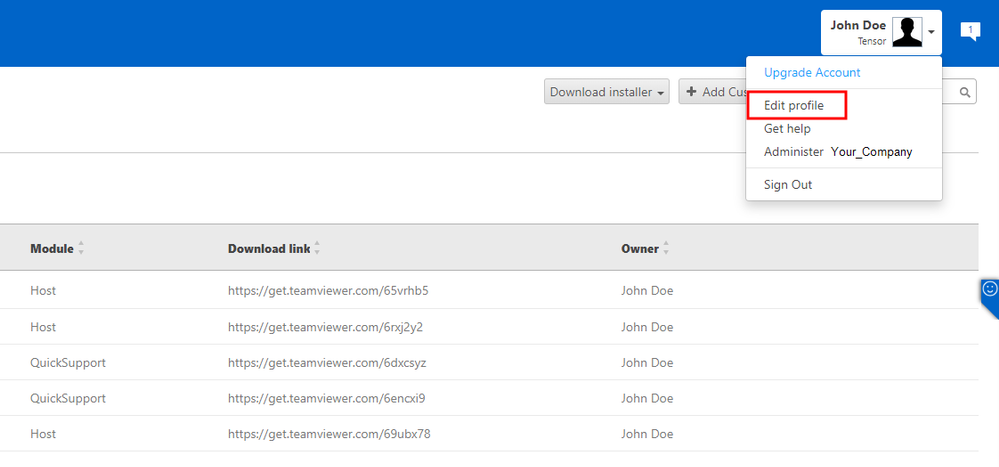
1.2 In the section apps, click Create script token
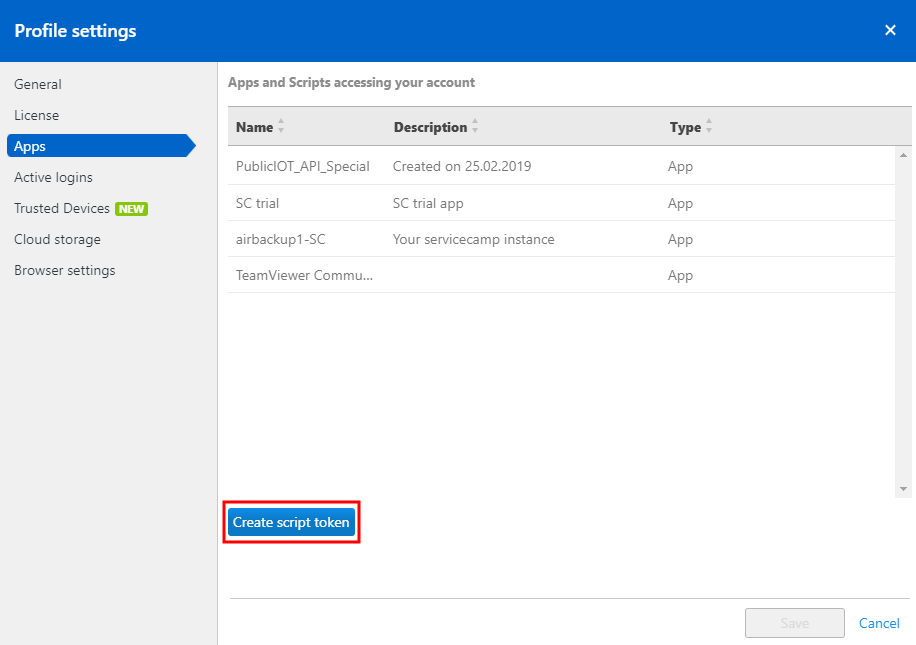
1.3 The token requires the following access permissions:
- User management: View users
- Group management: View, create,
delete, edit and share groups
- Computer & Contacts: View, add, edit
and delete entries

Step 2: Create a CSV file as a preparation for the mapping
The file needs to be in CSV format (using "," comma delimiter) and must provide the following 3 columns:
- Email
- Device
- TeamViewerID
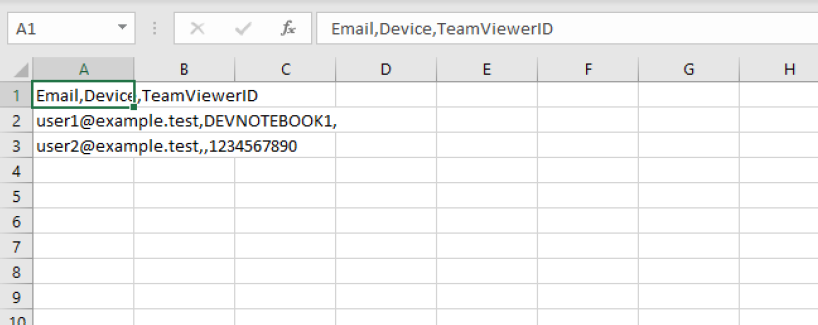
Step 3: Run the script
The script can be executed in 2 different modes:
a) Only devices contained in the admin group will be considered for the mapping.
b) All devices will be considered.
Once the script has run successfully, a group has been created for each user and the user has been added as additional manager of thre group, granting him the same permissions as the group owner (= admin), particularly Easy Access.
Example 1:
.\Invoke-TeamViewerGroupPerUserSync -ApiToken 'MyApiToken' MappingFilePath 'MyMappings.csv' -SourceGroupName 'My Computers'
Example 2:
.\Invoke-TeamViewerGroupPerUserSync -ApiToken 'MyApiToken' MappingFilePath
'MyMappings.csv' -IgnoreSourceGroup
Step 4: Make sure the execution of the script will be repeated automatically
Create a scheduled task that runs the script regularly.
This will make sure that devices that were offline during the first script execution will be configured for Easy Access.
Example for a log file created by the script:
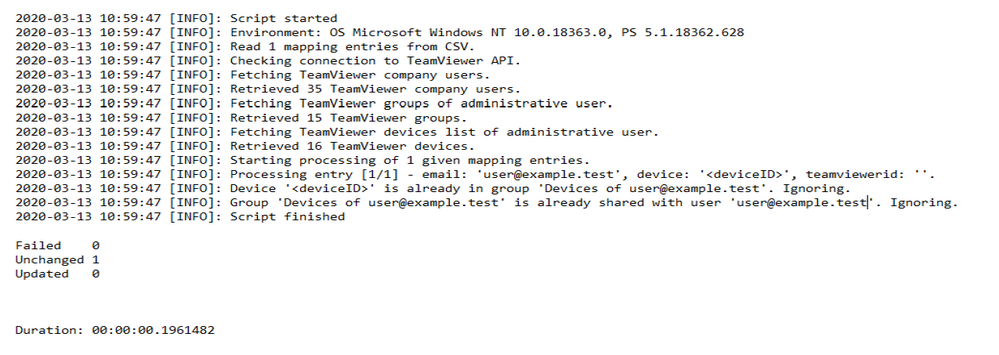
Step 5: Connecting your remote workers
Note: Please see our User Quickstart Guide "How to Use TeamViewer to Access Your Company Device from home" for detailed instructions.
- Ask your remote workers to download and install TeamViewer on their computers.
- After they log in their TeamViewer accounts, they will find their company computer in the Computers & Contacts list.
- With a double-click on their company device, they are connected to their remote computer.
